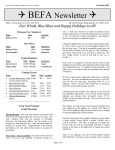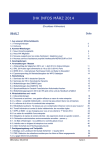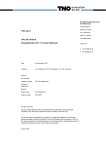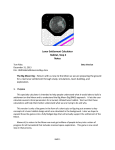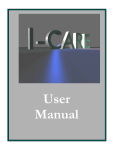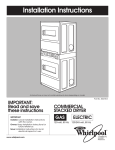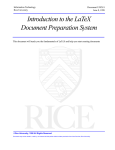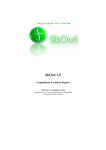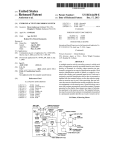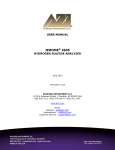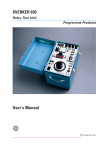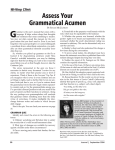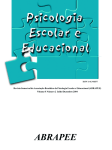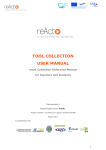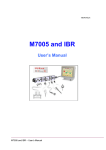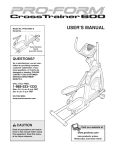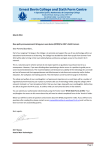Download fulltext - DiVA Portal
Transcript
REPORT Authors Gunnar Karlsson, KTH, SICS Date 2015-05-18 Report number TRITA-EE 2015:028 Sverker Janson, SICS How to create blended learning Guidelines for improved teaching with flipped classroom and active learning 1 (17) REPORT Date 2015-05-18 Report number TRITA-EE 2015:028 Summary In this report we present guidelines for developing and giving courses that blend online and in-class instruction, offering a simple default based on the Flipped Classroom and Peer Instruction teaching models and use of a web-based teaching platform. The guidelines naturally fall into two parts, developing new courses and giving already developed courses. Gunnar Karlsson and Sverker Janson: How to create blended learning 2 (17) REPORT Date 2015-05-18 Report number TRITA-EE 2015:028 Content Summary ......................................................................................................................................................2 1. Teaching Model.........................................................................................................................................4 1.1 Flipped Classroom ...............................................................................................................................4 1.2 Student Preparation ............................................................................................................................ 5 1.3 Meetings in Class ................................................................................................................................ 5 2. Course Development ................................................................................................................................6 2.1 Contents and Online Activities ...........................................................................................................6 2.2 Equipment and Software ................................................................................................................... 8 2.3 Creating Online Presentations ...........................................................................................................9 2.4 Creating Online Interaction ............................................................................................................. 11 2.5 Sharing and Reusing Courses and Course Material......................................................................... 13 3. Giving Courses........................................................................................................................................ 13 3.1 Combining Online and In-Class ....................................................................................................... 14 3.2 Examination ..................................................................................................................................... 15 3.3 Keeping it All Together ..................................................................................................................... 15 4. General Tips and Summary ................................................................................................................... 16 Acknowledgment ........................................................................................................................................ 17 References .................................................................................................................................................. 17 Gunnar Karlsson and Sverker Janson: How to create blended learning 3 (17) REPORT Date 2015-05-18 Report number TRITA-EE 2015:028 1. Teaching Model Summary points It is scientifically proven that active learning is more effective than passive learning. Students prepare in advance to maximize the usefulness of meetings with the teacher. Break down a course in reasonable-sized learning modules and tailor the teaching to the contents of each module. This guide to blended learning is based on the finding that the improvements of active learning, in which students engage actively in the learning process throughout a course, are substantial and well documented (Freeman 2014). It is the student who is more or less active. A student may activate him- or herself, but not all students have the capacity, motivation and self-discipline to do so. Lecturing tends to result in passive listening aimed at recording mentally what has been taught, perhaps with some note taking as the sole activity by the student. The study by Freeman et al. shows that pedagogic models in which the student is more active and engaged in the learning process have superior results. The study forms the scientific basis for the teaching model presented in this report. We discuss how to combine traditional and digital course material with on-campus classroom instruction and online interactive activities, and how to structure these elements effectively into a concrete teaching model that we refer to as Flipped Classroom. 1.1 Flipped Classroom In traditional teaching, new material is introduced in lectures, and students are given reading assignments, homework and projects to further develop their understanding. The basic idea in Flipped Classroom teaching is to reverse this: Students are given as homework the preparation for class, and the classroom time is spent on active learning together with other students under the guidance of the teacher. A course might be broken into learning modules. The structure of a course module is illustrated in Fig. 1. It shows the preparation, which precedes the class meetings, with examples of instruction such as video lectures, reading assignments and quizzes for assessment of the independent learning. Class meeting assumes preparation by the students and may begin by verifying the learning and correcting misunderstanding. Time is then spent on active in-depth learning. An outlook on the following module may be used to provide connections between modules to support the students in integrating the knowledge to a greater whole. Research shows that students learn best when they first have to tackle a material and experience the problems of understanding it before having it explained; see for instance challenge-based learning (Johnson 2011) and Merrill’s first principles of instructional design (Merrill 2002). Following the preparation by the students themselves, time in class may be used for verifying and reflecting on the preparatory learning and for getting deeper into the subject, ultimately to ensure that the students not only memorize facts but also meet higher-level educational objectives (e.g. Bloom’s comprehension, application, analysis, evaluation, and synthesis (Airasian 2000)). Gunnar Karlsson and Sverker Janson: How to create blended learning 4 (17) REPORT Date 2015-05-18 Report number TRITA-EE 2015:028 Figure 1: Illustration of a flipped-classroom learning module. The students prepare by self-study for meetings in class. The preparation may consist of video presentations, quizzes and reading assignments. Meetings in class will clarify difficulties and misconceptions from the preparation; most time will be spent on getting in depth of the subject, and the meeting might close with an outlook on the following learning module. 1.2 Student Preparation The guidelines herein assume preparatory instruction by online video presentations interspersed with quizzes. Preparing for class can be done without online learning tools, but their use will simplify the task for both teachers and students. Most tools offer self-correcting quizzes that provide instant feedback to students on their preparation progress and some provide data on each student’s individual interactions with the system: how and when video presentations were viewed, results for online quizzes, interactions on chat forums, and more. Using such information to prepare for the meetings in class (Formative Assessment) is an integrated element of full Flipped Classroom teaching. The teacher may select useful items for discussion in class, such as quiz outcomes or students’ questions. 1.3 Meetings in Class The active learning should continue in the classroom. A well-tested method is Peer Instruction by which students get engaged in discussion around questions posed by the teacher (Mazur 1997). The basic technique is to pose a question that the students first answer individually, then discuss with a peer and then answer again. The correctness of the first answer is not revealed until the second answer has been given. The common case is that the second answer is correct more often than the first one. It manifests the learning that takes place when the students discuss. You may use clickers, colored cards, hands in the air, or any other means to report the answers. There are several other techniques that may be employed to make the class time into an active learning session (for examples, see Wieman 2014). Note that the model we espouse is different from the online pedagogic model used by massive open online courses, MOOCs (Daniel 2012), which do not have physical meetings. We do not discuss such Gunnar Karlsson and Sverker Janson: How to create blended learning 5 (17) REPORT Date 2015-05-18 Report number TRITA-EE 2015:028 online-only courses albeit the suggestions herein for producing online material may be applicable also for that teaching model. 2. Course Development This section proposes practical guidelines for developing new courses and preparing new course material that use an online learning management system. The guidelines below pertain to preparation of video-based material. 2.1 Contents and Online Activities Summary points Provide online information on the structure of the course and its pedagogic model. Prepare an online module on your expectations of the prerequisite knowledge. Make a syllabus that actually can be learnt. You need a syllabus for the course that states expected prior knowledge, learning outcomes, verification of the outcomes as well as examination and grading of the students’ performance. Be cognizant of the time it actually would take to learn what you include in the syllabus. Prepare information for the students about the structure of the course and its pedagogic model (see Fig. 2); this is especially useful if the students are not used to the flipped-classroom model. State your expectation on preparations before class meetings and help the students to understand the inherent logic of the course to avoid unintended surprises. This may be done through an online presentation to get the students familiar with the online system from the start. This form of meta-information about the course may be continued for each learning module. You may describe the intended path towards learning. It could start with a diagnostic quiz initially to experience the difficulty of the subject matter followed by a reading assignment, a video lecture in several parts with further quizzes, ending with a homework assignment to hand in. This will assist the students in understanding what to do and why it is necessary, in order to promote their motivation. You might also want to prepare a module on your expectation on the prerequisite knowledge of the students. It could contain both quizzes that check the assumed knowledge as well as questionnaires for self-assessment where the student can tick off itemized concepts, indicating for instance applicable knowledge, familiarity and no prior knowledge. The results allow you to see whether you need to rehearse concepts and whether any student is insufficiently prepared for the course. You should also express your expectations on the students’ work, both in terms of effort and quality as well as ethics and conduct. Be explicit about the bases for grading and the policy for misconduct. Also inform the students that they will be monitored online: Studies are business and not private life. Privacy with respect to the teacher is the same online as in the classroom; a difference is that students do not see each other online, except for direct interactions and in course forums. Avoid allowing anonymous comments online. If you allow pseudonyms so that students are unidentifiable to each other, make sure that you have access to their true identities for control, and that students have agreed to etiquette rules at the beginning of the course. It is useful to have them acknowledge your policies regarding monitoring and personal conduct by posing them as quiz questions in the introductory online course module. Gunnar Karlsson and Sverker Janson: How to create blended learning 6 (17) REPORT Date 2015-05-18 Report number TRITA-EE 2015:028 Course progress Course parts About the course Prerequisites Learning module Learning module Examination Video Video Preparation Preparation Video Quiz Quiz Class Class Written Selfassesment Figure 2: The information about the course contains information about the structure of the course and its pedagogic model; needed prerequisites are summarized and checked by quizzes and self-assessment. The first two modules would be online, the learning modules are shown in Figure 1, and the final examination could be any combination of written exams and recorded presentations. Returning to the actual contents of the course, you need to decide how each part should be taught. You have many possibilities to explore and several media and modes might be applied for one and the same course module in order to cater to students’ different learning styles and because variety might be efficient and stimulating. Hence consider reading assignments, own research of a topic (with or without provided sources), online presentations, group assignments, preparation of presentations for class meetings, student essays, voice recordings and videos, as well as problem solving. Here is an example. Students are asked to develop a specific system. The online material and reading gives them sufficient background to solve the task. They might be allowed to work in groups but need to document their work and individual contributions daily on a wiki that the teacher monitors to ascertain progress for each student. When meeting in class, each group presents its design and its validation. The teacher may then lead a discussion of the pros and cons of the different designs. When you map teaching methods to the different parts of the course contents, you should also consider how you will monitor the learning. For instance, if you have both video presentations and reading assignments, you might check both by quizzes in the video if reading precedes viewing. Remember that the monitoring serves three purposes: first, as diagnostic test for the student that he or she has learnt what was taught; second, for the teacher to see that the students prepare for class and, third, to identify sections where many students have problems owing to inherent difficulty of the concept or because the material was not clear, or that their background was lacking. These sections may then be reviewed and discussed in class to ensure that they are understood. Passing quizzes is also motivating for the student. The results may be summarized in a scorecard to serve as a gauge of the students’ own results and to show improvements. It might not be good to let students compare against one another since it may de-motivate slower learners. Gunnar Karlsson and Sverker Janson: How to create blended learning 7 (17) REPORT Date 2015-05-18 Report number TRITA-EE 2015:028 2.2 Equipment and Software Summary points You need a capturing tool and a microphone to make videos. Make test recordings with the equipment you have. Figure 3: Screen-capture tool Camtasia in editing mode (top), and peripherals (bottom): writing tablet, document camera and table-top microphone. You need some equipment to record material for online use, in addition to a computer (see Fig. 3). There are many software tools to record the computer screen into video, for instance Camtasia from Techsmith and web-based tools such as Screencast-o-matic and Dreambroker. These tools make video of the presentation that you run on your computer and they capture audio, cursor movements, highlights, as well as everything else that appears on the screen, such as notifications of received emails and contacts that have come online. Thus stop all other programs before you start recording. The screen capture tools also contain editors for cutting and pasting video clips and sound tracks, and more. A writing tablet might be useful for handwriting and for annotating slides while talking. It allows better precision for pointing and highlighting than a regular mouse. The more expensive models have a LCD display so that you annotate directly on the image that you see and capture. For other types of video material you might want a document camera if you are going to write on paper and demonstrate manually; a web camera to capture you while speaking, or a camera fixed on a tripod if you want to be captured at the board. The camera in your smartphone might serve well. Ensure also that you have good lighting where you will record. Do test recordings. Gunnar Karlsson and Sverker Janson: How to create blended learning 8 (17) REPORT Date 2015-05-18 Report number TRITA-EE 2015:028 You may use a headset or a more advanced microphone for the audio. The sound quality is very important. Hence, make test recordings to check that it works (for instance, the microphone of a headset might pick up noise that is not annoying for a VoIP call but which might be audible on a recording). Consider whether you want a lapel microphone fixed to your clothes, a handheld one, or one fixed in a stand. Finally you need a site where you publish the videos. If you do not have any designated site, use YouTube or Vimeo. Note that you do not need to make your videos public: simply select the desired setting. The videos are then to be linked into the learning management system where quizzes are added and through which the students will access the videos. 2.3 Creating Online Presentations Summary points Recorded video segments should be limited to about five to ten minutes. Design each video in terms of what you will say and how you will present it. Online presentation allows a sense of intimacy: use it. Recording yourself is a new challenge for most lecturers. The important part is to get started. A useful minimum is to record a brief overview of each learning module (preparation for class must then be based on readings and other self-study assignments). Eventually you will be prepared to expand. Table 1 summarizes finding and recommendations of Guo et al. (2014). Be reminded that the human attention span is short. Hence your recorded video segments should be restricted to a few minutes, at most ten. It is also a reasonable unit for production since it allows updating your course by re-recording a segment without touching the whole. Taking an existing 45minute lecture and breaking into five to ten minute pieces might however not work well. Hence, structure the contents you plan to teach into reasonably sized topics, consider how you will present each topic. One approach could be to spend a few minutes giving an easily accessible overview of the topic and how you intend to present it, then describing the detailed parts and their interrelationships. For each short presentation that you make, you need to decide on its contents and to design it. You might need a fully written-down manuscript in order to remember what to say and not to say more than that. Consider using hierarchy and abstraction; examples, analogies and generalizations; analysis and reasoning. If you see two, three or more ways to explain a concept, why not recording them all? If a student did not understand it one way, another might unlock the ideas instead. (Contrast this to a book that often provides only one line of reasoning that could lead towards understanding.) Here are some tips for recording video presentations. Do not complicate the process: try to use or mimic teaching situations that you are accustomed to. If you are accustomed to talking while standing in front of class, stand up also when you record: it affects your way of speaking. If you need an audience, record in a meeting room with a few persons present. What should you record? Perhaps yourself when talking into the camera. It is good at the start of a course for giving a personal greeting, and when you really want to talk directly to the students to remind or alert them of something. It has limited appeal if used much. The online presentation allows a sense of intimacy: that the teacher sits with the student to teach him and her on a one-to-one basis. Writing on paper or a tablet while talking may give this sense; talking over a slideshow with or without annotations works too. You could mix the slides with a picture-inGunnar Karlsson and Sverker Janson: How to create blended learning 9 (17) REPORT Date 2015-05-18 Report number TRITA-EE 2015:028 picture video of you presenting them, but be cautious of having the attention drawn inadvertently to the talker instead of the slides. You may also be at a board as if giving private tutoring to the student. The board could be prepared with drawings and text in advance of the recording. All of these modes and any you can imagine will work and the recommendation is to use all of them where appropriate for variation. What does not work can be re-recorded. Finding Recommendation Shorter videos are much more engaging. Invest heavily in pre-production lesson planning to segment videos into chunks shorter than 6 minutes. Videos that intersperse an instructor’s talking head with slides are more engaging than slides alone. Invest in post-production editing to display the instructor’s head at opportune times in the video. Videos produced with a more personal feel could be more engaging than high-fidelity studio recordings. Try filming in an informal setting; it might not be necessary to invest in big-budget studio productions. Khan-style tablet drawing tutorials are more engaging than PowerPoint slides or code screencasts. Introduce motion and continuous visual flow into tutorials, along with extemporaneous speaking. Even high quality pre-recorded classroom lectures are not as engaging when chopped up for a MOOC. If instructors insist on recording classroom lectures, they should still plan with the MOOC format in mind. Videos where instructors speak fairly fast and with high enthusiasm are more engaging. Coach instructors to bring out their enthusiasm and reassure that they do not need to purposely slow down. Students engage differently with lecture and tutorial videos For lectures, focus more on the first-watch experience; for tutorials, add support for re-watching and skimming. Table 1: Summary of recommendations by Guo et al. on video production for online instruction (Guo 2014). Always make it easy for the students to follow both what you are saying and what is shown on screen. Whichever style of recording used, direct your viewers’ attention by writing, drawing, underlining, pointing to, or animating salient items during the presentation. Avoid still images of slides with text. Recording a presentation on screen while talking, annotating and pointing might simply be too many simultaneous tasks. Hence, record your voice first and then add slides and annotations (or in any other order). When you make a mistake, remember that you will edit it out later. Edit the presentation to format and review it; have colleagues and students to critique it before you finalize the editing and publish it for use in the course. Gunnar Karlsson and Sverker Janson: How to create blended learning 10 (17) REPORT Date 2015-05-18 Report number TRITA-EE 2015:028 Figure 4: Video presentations might be recordings of: a speaker (top left), slides with annotations (top right), handwriting (bottom left), and lecturing at a board (bottom right). 2.4 Creating Online Interaction Summary points Quizzes should promote learning and not be a base for examination. Let students experience that you learn when you teach. The recorded materials along with reading assignments form the basis for class-preparations. However, adding interactivity will make the study more efficient. We have already said that the videos could be interrupted by quizzes, as supported by most learning management systems. The quizzes are simple multiple-choice questions for which you indicate the correct answers and the system then marks them automatically. Now you need to consider the quiz questions that you will add to your presentation. They should help confirm to the student that she or he has learnt what was expected and to the teacher that the students collectively have done so. Hence the quizzes should address the major elements to be learnt in a course module with about one or two quizzes per video segment. There are several forms of quizzes so explore the possibilities. For good effect, the alternatives in multiple-choice quizzes should be close to one another while being separated by some important aspect to be reckoned by the students. Answering should require thought! The correct choice should not be evident by a superficial scan of the alternatives, excluding the others as obviously incorrect. Based on your experience, try to capture common misunderstandings in the alternatives. A straightforward use of quizzing is to pose a question and to show whether the student gave the correct answer or not, followed by an explanation of the choices and why they are right or wrong. Explain to your students that the sole purpose of these quizzes is to promote learning; that the quizzes Gunnar Karlsson and Sverker Janson: How to create blended learning 11 (17) REPORT Date 2015-05-18 Report number TRITA-EE 2015:028 are not a basis for examination; that it is in the students’ own interest to get the questions right, and that they should understand why they got an answer wrong before proceeding. An incorrect answer should be a signal to think more deeply, to review the relevant material, and perhaps also to look for additional material to help understand the topic at hand. Correct answers should indicate that the student is sufficiently well-prepared for the subsequent in-class activities. If the class size is reasonable, then you may add free-text answers to openly phrased questions on the material. You may for instance ask the students to itemize the three-four most important points in the module. They may also provide their own questions that could be compiled, edited and offered back to the class as review questions. Make sure that you have time to read what they submit; hence, the larger the class, the more automatic the feedback must be. Figure 6: Any form of hand-in may be peer-reviewed. The reviewers provide comments on the hand-in for revision. The author may in turn give feedback on the usefulness of each provided review. Hence, both parties in the process will learn. One resource that grows with the number of students is the peer-instruction capacity. Many teachers have experienced that you learn when you teach; let students have the experience by supporting one another (see Fiorella 2013 for a study of the efficacy of learning by teaching). Students may write freetext comments, summaries and questions on an online module; each text could be reviewed by a few other students and then revised by the authoring student. The collection of finalized summaries may serve as reviewing material for the course. Peer reviewing may be extended to term papers, project reports, slide sets for class presentations, program code, system design and all forms of student generated contents. The reviewer could grade the quality of the reviewed contents and the author could in turn grade the reviewer on how useful the comments and critique are. The process is illustrated in Fig. 6. The peer-instruction method to pose a question that the students first answer individually then discuss with a peer and then answer again may be used online with chat or Skype for the discussion. A restriction is that the students should be online at the same time, and hence the session needs to be scheduled. A suggestion to emulate the teaching-is-learning experience further would be to provide material with errors unbeknownst to the students. They may then make corrections individually, at first, and then in pairs or small groups compare notes to identify all mistakes. It is especially useful if the mistakes are such that the students make themselves, for instance compiled from a prior assignment; that Gunnar Karlsson and Sverker Janson: How to create blended learning 12 (17) REPORT Date 2015-05-18 Report number TRITA-EE 2015:028 assignment might then be corrected by the student and handed in with changes tracked to see if the mistakes were caught. The idea is to train the students in quality control of their own and others work. 2.5 Sharing and Reusing Courses and Course Material Summary points Material in digital form is easy to extend, update and to share. Sharing of course material increases efficiency of course development. Reuse complete online courses by adding laboratory, in-class discussion and examination. All material should be prepared for reuse: first, for your own reuse when you give the course again; second, when colleagues give the course and, third, when components of it are used in other courses. The tools you use will help, and the fact that your material is in digital form makes it easier to update and edit it. For instance, the video sources should be kept so that you may re-edit the published videos if need be. Quiz questions may easily be corrected or changed. There should not be any difficulty in revising your own material for coming course rounds. Consider revising the material during the course round or immediately thereafter since impressions and ideas wane fast. You might also want to use video material produced by others. It could be public presentations such as TED talks or presentations shared with you. You may then simply link them in the learning management system to your course, which allows you to add quizzes and to get viewing statistics for them, which is not possible if the students view the presentations directly from the publishing site, for instance YouTube. You might edit and shorten the presentation to the format you need if the copyright protection allows it. We expect that publishing and sharing of components of course material will increase because it is efficient to pool development efforts. Each teacher may then build a course based on the best components for the subject, which might not be her or his own. Widespread use of Creative Commons licenses will help reuse. A more comprehensive reuse is to build upon complete online courses, for instance the massive open online courses offered by universities directly as well as by Coursera, edX, FutureLearn, Iversity, Udacity and other companies. They are in principle fully self-contained. You may add in-class meetings to monitor the learning and to make it more profound and supplementary instruction such as laboratory sessions and projects. You also provide examination based on your institution’s criteria for awarding credits. 3. Giving Courses This section proposes practical guidelines for giving courses that have been prepared according to the Flipped Classroom teaching model. A successful course depends not only on course contents and teaching methods but also on clear expectations and commitments from all parties (students, employers of professional students, the university, the professor). Not least, it must be perfectly clear that students have the time to work on the course. For campus students it means that the total workload of the courses running in parallel Gunnar Karlsson and Sverker Janson: How to create blended learning 13 (17) REPORT Date 2015-05-18 Report number TRITA-EE 2015:028 remains feasible to handle; for professional students, it means that they may study on work hours, at least in part, and that this is endorsed by the employer. 3.1 Combining Online and In-Class Summary points Preparations have preempted any need for lecturing. Misconceptions and gaps are identified by the learning management system. Before ending class, make an outlook on the next module of learning. The basic idea when flipping the classroom is to prepare the students for the meeting with the teacher. In secondary and tertiary education as well as professional education, teachers have expert knowledge and are scarce resources in the educational process. Hence, it is important to use them well for what they are most valuable: getting in depth into a topic. The preparations have preempted any need for lecturing. With proper online material and reading assignments, you will meet a classroom full of well-prepared students. Use their time wisely! The overall aim should be to clarify any misconceptions and gaps in understanding from the preparation, and to get deeper into the studied subject. You should also offer other forms of instructor-led activities (laboratory, seminars, recitations, study visits, and fieldwork; not discussed herein), as well as projects and other group work, and finally some form of examination. The learning management system gives the teacher data on the progress and preparation of all students in the course before meeting them in class. Hence, plan to put a deadline on the preparations well ahead of the meeting to allow time for tailoring the instruction to the performance on the preparation for the module. Misconceptions and gaps are thus identified based on data from the learning management system, such as the results of the quizzes and student questions as well as viewing statistics for videos. You might need to review and to teach a particular topic again if the students in general did poorly on the quizzes or were otherwise confused. Their difficulties could be due to shortcomings in the presentation of the material or due to some inherent complexity of the concept being taught. Getting deeper into the subject relates to what your goals are for the course. Examples of activities are problem solving and discussions in small groups followed by discussion in plenary. Consult texts on peer instruction in particular and pedagogics in general for suggestions if need be. You may increase interactivity by means of clickers that automatically log responses from an audience (see Robertson 2000 and Wieman 2014 for advice on usage). If class size permits, there are time-tested techniques such as Socratic questioning and the disputation where a student defends a point of view against opponents. It is important to give attention to all students in class so that all will be seen. It gives a sense of responsibility and social control that might increase the students’ motivation to prepare. Ensure that all students are active in class and get a proper chance to participate; allow time for thinking before expecting answers back on a challenging question. Seek out answers also from those who do not readily volunteer to answer. Before ending class, make an outlook on the next module of learning: the topic and the preparatory material as well as the contents of your next meeting in class. Explain how it builds upon or complements what has been taught this far (Merrill 2002). Gunnar Karlsson and Sverker Janson: How to create blended learning 14 (17) REPORT Date 2015-05-18 Report number TRITA-EE 2015:028 3.2 Examination Summary points Make cumulative tests on the synthesis of the entire course material. Verify higher educational objectives such as comprehension, application and analysis. Use preparations as well as class activities for examination. If you are teaching a class that has been offered before in a regular format, consider keeping the examination unchanged for a year or two as a gauge of changes in results owing to your new teaching model. You might add supplementary examination. The main goal is to test the students against the learning objectives of the course. You may use the preparations as well as the class activities for examination. A basic requirement for each student is to complete most preparations online and to attend class in order to pass. It could be expanded with regular hand-ins and tests dispensed in class to serve as complete or complementary examination for the course. Hence consider the full scale from the two extremes with one end being a final exam at the end of the course over to the other extreme being a series of examinations on the different course modules. Remark that the final exam is cumulative over all contents and might test the synthesis of the parts, which is not possible if each part is tested independently. Each of a series of exams may however be cumulative over the material taught thus far. The joint design of instruction, formative assessment (testing for diagnostic purposes, such as online quizzes) and summative assessment for examination is challenging. The combination is however powerful for effective teaching. It is important that the assessments address higher learning objectives and that they do not merely test memorization of facts and rule-based calculations (Airasian 2001). Depending on class size and subject, you may use also audio-visuals for examination, such as video and audio recordings of the student solving a problem or explaining a concept. Hence you are not limited to essays and written project reports. Exams may be administered digitally, if proctored in a classroom. There are systems, such as Digiexam, in use. They simplify the handling of the exam and avoid using paper. Multiple-choice questions may be machine graded. Online examination is still difficult to trust, for instance with respect to authentication of the students’ identities and to prevent additional persons and resources being available at the students site to assist with the test. However, these problems are no greater than with take-home exams, which are commonly used. 3.3 Keeping it All Together Summary points Invite other teachers to your online material for connecting it to their own courses. Allow the students indefinite access to the online material for review after the course ends. Think about the context of your course: whether an entire educational program, a major of a program, or a preparation for – or part of – work life. Connect to the context. You may for instance consult with colleagues who teach courses that are prerequisites for your course to design a diagnostic test together with you on the retention of the needed knowledge from those courses. Invite those teachers as well as teachers who rely on what you inculcate to students into the Gunnar Karlsson and Sverker Janson: How to create blended learning 15 (17) REPORT Date 2015-05-18 Report number TRITA-EE 2015:028 learning management system so that they may see your online material and connect to it in their own courses. Do not let go of students simply because they have passed the course. Allow them continued access to the online material for review. If you provide a review in class at the end of the course, then open it also to prior students. And why not allowing them to retake the final exam if one is provided? You could provide a certificate of the result, allowing the person to show retention of the knowledge, as could be needed for a new job. Support lifelong learning. If time permits, set up a podcast or Twitter feed and invite past students to follow the development of the subject, seen from your perspective, with invitations to said reviews and exams. Check course evaluations and results from courses that build on your own. Do you see any comments that you might address in your course rather than in that other course? If your course provides professional training, try to get feedback from your former students after they graduated and ideally also from their peers, subordinates and managers when relevant. Be inviting to take questions from them in your area of competence. 4. General Tips and Summary With the following tips we would encourage you to get started. Have reasonable expectations. It takes time to design and prepare a blended course. Control your strive for perfection since it might kill your interest. The quality of video presentations has not a strong impact on student learning. Update when needed. Invite feedback. Sort comments along two axes: importance and ease of implementation. Start with the right combination. This guide builds on the premise that active learning, where students take responsibility for their own learning, is provably superior to lecturing and reading. One form of active learning is blending of classroom and online instruction that is designed to activate the students. Online material and the tools used to dispense it support the students’ own work in terms of promoting self-control and self-assessment of acquired knowledge, as well as learning through different media and modes of instruction. The tools also allow monitoring of the students’ work by the teacher. Hence, online teaching might boost the quality and efficiency of teaching in higher education and in professional education. By online preparation, the teacher may use the meetings in class to getting in depth into the subject. For further reading we recommend the Course Transformation Guide by Wieman (2014) and First Principles of Instruction by Merrill (2002). Gunnar Karlsson and Sverker Janson: How to create blended learning 16 (17) REPORT Date 2015-05-18 Report number TRITA-EE 2015:028 Acknowledgment This report has been produces within the project PROMPT, Professionell masterutbildning i programvaruteknik, funded by KK-stiftelsen. The text has been reviewed and commented on by the following persons at KTH: Juliette Soulard, Lotta Nilsson and Ida Naimi-Akbar. We are grateful for their constructive comments. References Airasian, Peter W., Kathleen A. Cruikshank, Richard E. Mayer, Paul R. Pintrich, James Raths, Merlin C. Wittrock, A taxonomy for learning, teaching, and assessing: A revision of Bloom's taxonomy of educational objectives, (Lorin W. Anderson, David R. Krathwohl, eds.) Longman, New York, 2001. Daniel, John, “Making Sense of MOOCs: Musings in a Maze of Myth, Paradox and Possibility,” Journal of Interactive Media in Education, 2012. Fiorella, Logan, and Richard E. Mayer, “The relative benefits of learning by teaching and teaching expectancy,” Contemporary Educational Psychology (Elsevier), Vol. 38, Issue 4, October 2013. Freeman, Scott, Sarah L. Eddy, Miles McDonough, Michelle K. Smith, Nnadozie Okoroafor, Hannah Jordt, and Mary Pat Wenderoth, “Active learning increases student performance in science, engineering, and mathematics,” Proc. National Academy of Sciences, vol. 111, no. 23, 2014. Gou, Philip J., Juho Kim, and Rob Rubin, “How Video Production Affects Student Engagement: An Empirical Study of MOOC Videos,” Proc. ACM Learning at Scale, 2014. Johnson, L., and S. Adams, Challenge Based Learning: The Report from the Implementation Project, Austin, Texas: The New Media Consortium, 2011. Mazur, Eric, Peer Instruction: A User's Manual, Prentice Hall, 1997. Merrill, M. David, “First principles of instruction,” Educational Technology Research and Development Journal (Springer), Vol. 50, No. 3, pp 43-59, 2002 Robertson, Lorraine J., “Twelve tips for using a computerised interactive audience response system,” Medical Teacher, Vol. 22, No. 3, 2000. Wieman, Carl, Course transformation guide, Science Education Initiatives, University of British Colombia and University of Colorado Boulder, April 2014. Gunnar Karlsson and Sverker Janson: How to create blended learning 17 (17)

















